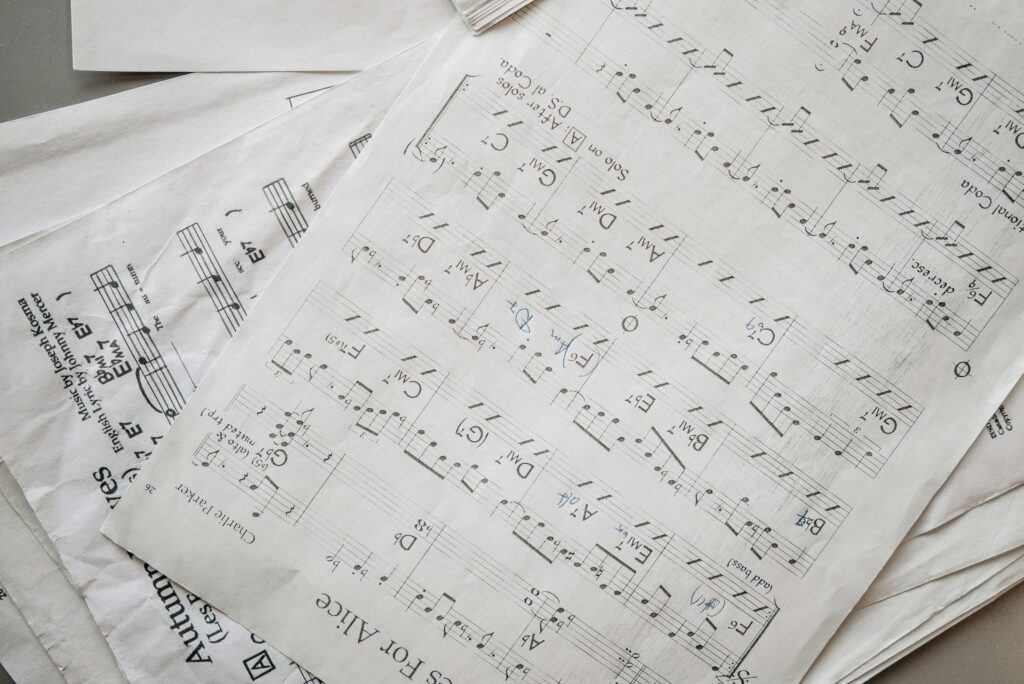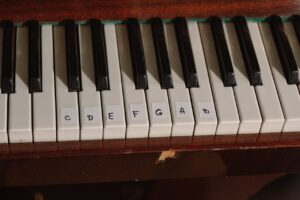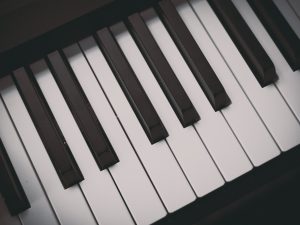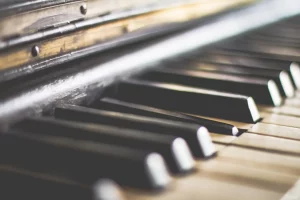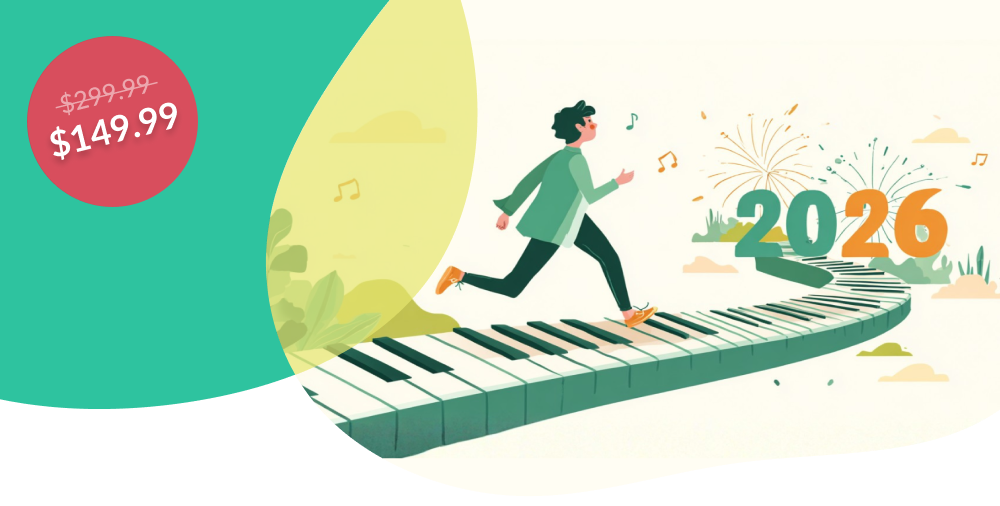Have you ever heard a song and been captivated by its smooth transitions or groovy bassline? You’ve already experienced the magic of slash chords. These versatile musical tools are the secret behind many iconic pieces. Slash chords add depth and emotion that elevates simple chord progressions to breathtaking compositions.
What exactly are slash chords and how can they transform your piano playing?
In this comprehensive guide, we will uncover what makes them special, why they’re essential for pianists and how to use them to unlock new creative possibilities.
- Fall in love with the music - Learn your favorite songs, at a level suitable for you.
- Enjoy interactive piano lessons - Explore courses covering music theory, technique chords & more.
- Get real-time feedback - Skoove's feedback tells you what went well and what needs practice.

What is a slash chord?
Simply put, piano slash chords are made up of two-parts; a standard piano chord played by your right hand and a specified bass note played by your left. They are written in a notation that looks like this: C/G, which is read as “C over G.” Here, the C represents the main chord, while the G is the bass note.
The chord provides the harmony while the bass note gives the whole structure its foundation. Together, they create a sound richer than the sum of their parts and offer more color than standard inversions.
Slash chords are often confused with chord inversions however they have two main differences:
- C/E (a slash chord) specifies that E is played as the bass note but doesn’t necessarily change a chord’s voicing.
- C in first inversion does place E as the bass note but rearranges the rest of the chord structure accordingly.
How to play slash chords on piano
Learning slash chords may seem daunting at first, but breaking them into manageable steps can make the process smooth and enjoyable.
Step-by-step guide:
1. Start with the main chord
Play the chord indicated before the slash (e.g., C in C/G) with your right hand. Make sure it’s clear and well-voiced.
2. Add the bass note
Using your left hand, play the bass note indicated after the slash (e.g., G in C/G). Place it lower on the keyboard to maintain clarity.
3. Combine and balance
Play both parts together, ensuring the bass note doesn’t overpower the chord. Focus on blending the sounds harmoniously.
Practice exercises:
- Begin with simple progressions like G – G/B – C – C/E – F.
- Once comfortable, experiment with more complex patterns, such as D – D/F# – G – A/C#.
- Use a metronome to maintain timing as you link chords smoothly.
Advanced players can explore variations, such as:
- Playing the bass note before striking the chord.
- Adding octaves or fifths to the bass note for a fuller sound.
Here’s a table to help clarify some common slash chords:
| Slash Chord | Main Chord | Bass Note | Description |
| Major | |||
| C/G | C Major | G (5th) | Creates a sense of movement |
| C/E | C Major | E (3rd) | The use of the 3rd makes the chord less stable and more interesting |
| C/A | C Major | A (6th) | The use of the major 6th hints at a more minor tonality |
| Minor | |||
| Cm/G | C Minor | G (5th) | Creates a sense of movement |
| Cm/E♭ | C Minor | E♭(3rd) | The use of the third makes the chord less stable and more interesting |
| Cm/A♭ | C Minor | A♭(6th, minor) | The use of the major 6th hints at a more major tonality |
Playing these interesting examples of a few common slash chords will give you a good insight into how they can alter the feeling of a chord.
Why are slash chords used in music?
Let’s dive deeper into why slash chords are so essential in music and how they create a significant impact across various genres.
Creating smooth transitions
One of the most common uses of slash chords is to create seamless transitions between chords. Without them, chord progressions can sound abrupt or disjointed. Slash chords enable a smoother flow by guiding the bassline through stepwise motion.
For example:
- In the progression C – C/E – F, the C/E acts as a bridge between C and F, allowing the bassline to rise gradually from C to E to F. This subtle movement makes the progression feel more cohesive and natural.
Adding emotional depth
Slash chords aren’t just technical tools, they are powerful emotional enhancers. The choice of a bass note can drastically change the mood of a piece or context of a chord in a progression. For example:
- G – G/B – C creates a feeling of hope and resolution as the bassline rises from G to B to C.
- Am – Am/G – F adds a touch of melancholy, with the descending bassline creating a sense of longing or sadness.
In cinematic scores, composers often use slash chords to evoke specific emotional responses. For instance, a progression like D – D/F# – G – A is a go-to in romantic or uplifting scenes because it builds tension and releases it in a satisfying way.
Enhancing harmonic texture
Slash chords can enrich a composition by dictating two distinct features, harmony and bass, with one symbol. This effect makes slash chords particularly popular in jazz, gospel and classical music, where complexity and depth are celebrated.
- In jazz, for example, A slash chord like C7/Bb adds a bluesy flavor, with the bass note contributing to the chord’s tension and release.
- In gospel music, progressions like D – D/F# – G – G/B are used to create cascading basslines that feel uplifting and spiritual.
In classical music, slash chords appear in the works of composers like Beethoven and Chopin, often used to create dramatic shifts in mood or to emphasize the bassline as a melodic element.
Supporting melodic movement
Slash chords don’t just affect harmony they can also be used to enhance a melodic line. A well-placed bass note can enhance the motion of the melody through context, making it feel more dynamic and expressive.
For instance:
- In the progression C – C/E – F – F/G – G, the bassline (C – E – F – G) mirrors the rising motion of a melody, creating a sense of balance and symmetry.
- In ballads, the descending bassline in Am – Am/G – F complements a melody that moves downward, reinforcing the song’s emotional weight.
- Slash chords can act as a counterpoint to the melody, creating a conversation between the bass and the top line. This interplay adds complexity and intrigue, drawing the listener deeper into the music.
Creating tension and release
One of the most satisfying aspects of music is the push and pull between tension and release, slash chords excel at this. By altering the bass note, they can introduce dissonance or anticipation that resolves beautifully into the next chord.
Consider this progression:
Dm – D/F# – G – G/B – C. The D/F# creates a moment of tension, as the F# bass note contrasts with the D minor chord. This tension resolves as the progression moves to G and then C, giving the listener a sense of completion.
Bridging genres and styles
Slash chords are incredibly versatile and can adapt to a wide range of musical styles. Here’s how they’re used in different genres:
- Pop music: Slash chords are often used to create catchy, flowing basslines. Think of “Let It Be” by The Beatles, where G – G/B – C – C/G makes the verses memorable and heartfelt.
- Rock music: Bands like Fleetwood Mac and Queen use slash chords to add sophistication to their chord progressions.
- Jazz: Complex slash chords like A7/G or C7/E are staples in jazz standards, adding richness and unpredictability.
- Classical: Composers use slash chords to introduce unexpected basslines that keep the listener engaged.
Slash chords are a powerful tool for composers and songwriters, offering endless opportunities for experimentation. They let you explore unconventional basslines without altering the underlying harmony, adding depth and complexity to your music. By incorporating subtle variations into familiar progressions you can achieve entirely new effects and moods. This flexibility allows for unexpected shifts in dynamics or tone, keeping your audience engaged and your music fresh. With slash chords, the possibilities are limited only by your imagination.
How to incorporate slash chords in your own playing
Slash chords are a gateway to musical innovation. Here’s how to explore their creative potential:
Improvisation:
Craft unique basslines to enhance melodies. Try starting with a progression like
- Am – Am/G – F – F/E, then build an improvised melody over it to develop your style.
Composition:
Shape the mood of your piece with purpose. For instance:
- D – D/F# – G – A conveys optimism and forward motion.
- Cm – Cm/G – Ab – Ab/Eb adds depth and drama for a more intense atmosphere.
By integrating slash chords into your improvisation and composition, you can unlock fresh possibilities and elevate your musical expression.
Common mistakes to avoid
Learning to play slash chords can be incredibly rewarding, but like any new skill, it comes with a learning curve. Here are some common mistakes to watch out for, along with tips to overcome them:
Understanding slash chord notation
- The part before the slash (e.g C in C/G) is the main chord, while the part after (G) indicates the bass note.
- Avoid thinking the bass note is part of the chord voicing. Instead, treat it as a separate element.
- Start with simple chords (C/G, G/B) before moving to complex ones (D/F#, A/C#).
Managing bass notes
- Keep bass notes in the lower register to avoid a muddy sound.
- Play the bass softly for balance and clarity.
- Use the sustain pedal carefully to prevent overlapping notes.
Balancing complexity
- Use slash chords sparingly for transitions or emotional moments.
- Avoid cluttering the music—ensure each chord serves the piece’s mood or flow.
- Review progressions critically to prioritize simplicity and impact.
Improving hand independence
- Practice each hand separately: the right hand plays the chord, the left handles the bass note.
- Slow down and use a metronome to coordinate timing and dynamics.
Maintaining rhythmic flow
- Focus on steady timing with a metronome or by counting out loud.
- Practice transitions between chords slowly to ensure smooth changes.
Examples of slash chords in popular music
Slash chords have left their mark on countless hit songs. Here are a few standout examples:
“Let It Be” by The Beatles
The classic G – G/B – C – C/G progression in the verse showcases how slash chords create a flowing bassline.
“Someone Like You” by Adele
Slash chords in this ballad provide emotional weight, particularly in the transitions between verses and choruses.
“Africa” by Toto
The intricate use of slash chords adds rhythmic and harmonic complexity, making the song’s iconic piano riff unforgettable.
Listening to these examples can inspire you to explore how slash chords add magic to music.
Review: tips for success
Here’s how to make your slash chord journey successful:
- Start with familiar songs
Try adding slash chords to pieces you already know. It’s a great way to build confidence. - Practice hands separately
Work on the bass note and chord independently before combining them. - Use a metronome
A steady tempo helps smooth transitions between chords. - Explore resources like Skoove
Interactive platforms like Skoove can guide you step-by-step in mastering slash chords, providing real-time feedback as you play. - Experiment fearlessly
Try slash chords in different styles—pop, jazz, even classical—to find your unique sound.
Unlock new possibilities with slash chords
Slash chords are a powerful tool that elevates your piano playing, offering a fresh layer of emotion and sophistication to your music. Whether you’re just starting out or an experienced performer, mastering slash chords can transform simple progressions into a truly captivating piece of music.
Ready to take the next step? With Skoove’s interactive lessons, you can seamlessly incorporate slash chords into your repertoire and bring theory to life and inspire your creativity.
Author of this blog post:
Susana Pérez Posada

With over seven years of piano education and a deep passion for music therapy, Susana brings a unique blend of expertise to Skoove. A graduate in Music Therapy from SRH Hochschule Heidelberg and an experienced classical pianist from Universidad EAFIT, she infuses her teaching with a holistic approach that transcends traditional piano lessons. Susana’s writings for Skoove combine her rich musical knowledge with engaging storytelling, enriching the learning experience for pianists of all levels. Away from the piano, she loves exploring new places and immersing herself in a good book, believing these diverse experiences enhance her creative teaching style.
Published by Lydia Ogn from the Skoove team







